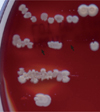Abstract
Haemophilus influenzae has rarely been implicated as the causative agent of urinary tract infections (UTIs). However, cases of UTIs caused by H. influenza in patients with anatomical or functional urinary tract abnormalities have been steadily reported. We report a case of asymptomatic bacteriuria caused by H. influenzae in a kidney transplant recipient. The patient was a 61-yr-old woman who visited the hospital for a routine follow-up after receiving a kidney transplant from a living-related donor; the patient showed no symptoms. Urine microscopy revealed white blood cell (WBC) count of >30/high power field (HPF). Urine culture on blood agar showed non-hemolytic, tiny, translucent, grayish colonies with satellitism around β-hemolytic colonies of Staphylococcus epidermidis. The organism in the satellite colonies was identified as H. influenzae by using VITEK Neisseria/Haemophilus Identification Card (bioMérieux, Marcy L'Etoile, France) and found to require both X and V factors for growth. The organism did not produce β-lactamase. Urine culture performed 1 week later revealed H. influenza again. The patient was not treated with antimicrobials. Urine culture performed using chocolate agar 7 weeks later did not reveal H. influenzae. Since H. influenzae does not grow in the media commonly used for urine culture such as blood agar, the use of these media could lead to underestimation of the true frequency of H. influenzae. If UTI is suspected in a patient with anatomical or functional urinary tract abnormality, chocolate agar should be considered for urine culture.
Figures and Tables
References
1. Forbes BA, Sahm DF, editors. Bailey & Scott's diagnostic microbiology. 2007. 12th ed. St.Louis: MOSBY ELSEVIER;403–409.
2. de Almeida AE, Caldeira NG, Schroeder LF, Batalha de Jesus AA, Serradas LR, da Costa AF, et al. Urinary tract infection caused by nontypable Haemophilus influenzae in the elderly. J Med Microbiol. 2010. 59:1132–1133.

3. Demetrios P, Constantine B, Demetrios S, Nikolaos A. Haemophilus influenzae acute pyelonephritis in the elderly. Int Urol Nephrol. 2002. 34:23–24.
4. Reichman JM, Alcalay R, Spectre G. Haemophilus influenzae pyelonephritis in adults. Arch Intern Med. 1999. 159:316.
5. Hansson S, Svedhem A, Wennerström M, Jodal U. Urinary tract infection caused by Haemophilus influenzae and Haemophilus parainfluenzae in children. Pediatr Nephrol. 2007. 22:1321–1325.

6. Garcia LS. Clinical microbiology procedures handbook. 2010. 3rd ed. Washington DC: ASM Press;3.12.6.
7. Ojeda-Vargas MM, Monzón-Moreno C, Checa-Andrés MD, Martín-Sánchez AM. Urinary infection by Haemophilus parainfluenzae in a renal transplantation patient. Enferm Infecc Microbiol Clin. 1994. 12:169–170.
8. Säemann M, Hörl WH. Urinary tract infection in renal transplant recipients. Eur J Clin Invest. 2008. 38(Suppl 2):58–65.

9. Chuang P, Parikh CR, Langone A. Urinary tract infections after renal transplantation: a retrospective review at two US transplant centers. Clin Transplant. 2005. 19:230–235.

10. Rivera-Sanchez R, Delgado-Ochoa D, Flores-Paz RR, García-Jiménez EE, Espinosa-Hernandez R, Bazan-Borges AA, et al. Prospective study of urinary tract infection surveillance after kidney transplantation. BMC Infect Dis. 2010. 10:245.

11. Dantas SR, Kuboyama RH, Mazzali M, Moretti ML. Nosocomial infections in renal transplant patients: risk factors and treatment implications associated with urinary tract and surgical site infections. J Hosp Infect. 2006. 63:117–123.

12. Ciszek M, Paczek L, Bartłomiejczyk I, Mucha K. Urine cytokines profile in renal transplant patients with asymptomatic bacteriuria. Transplantation. 2006. 81:1653–1657.

13. Muñoz P. Management of urinary tract infections and lymphocele in renal transplant recipients. Clin Infect Dis. 2001. 33(Suppl 1):S53–S57.

14. Goya N, Takahashi K, Tanabe K, Osanai K, Asahina Y, Oba S, et al. Clinical studies of bacteriuria in renal transplantation recipients. Correlation with pyuria and symptomatic genitourinary tract infection. Nihon Hinyokika Gakkai Zasshi. 1991. 82:947–954.




 PDF
PDF ePub
ePub Citation
Citation Print
Print




 XML Download
XML Download